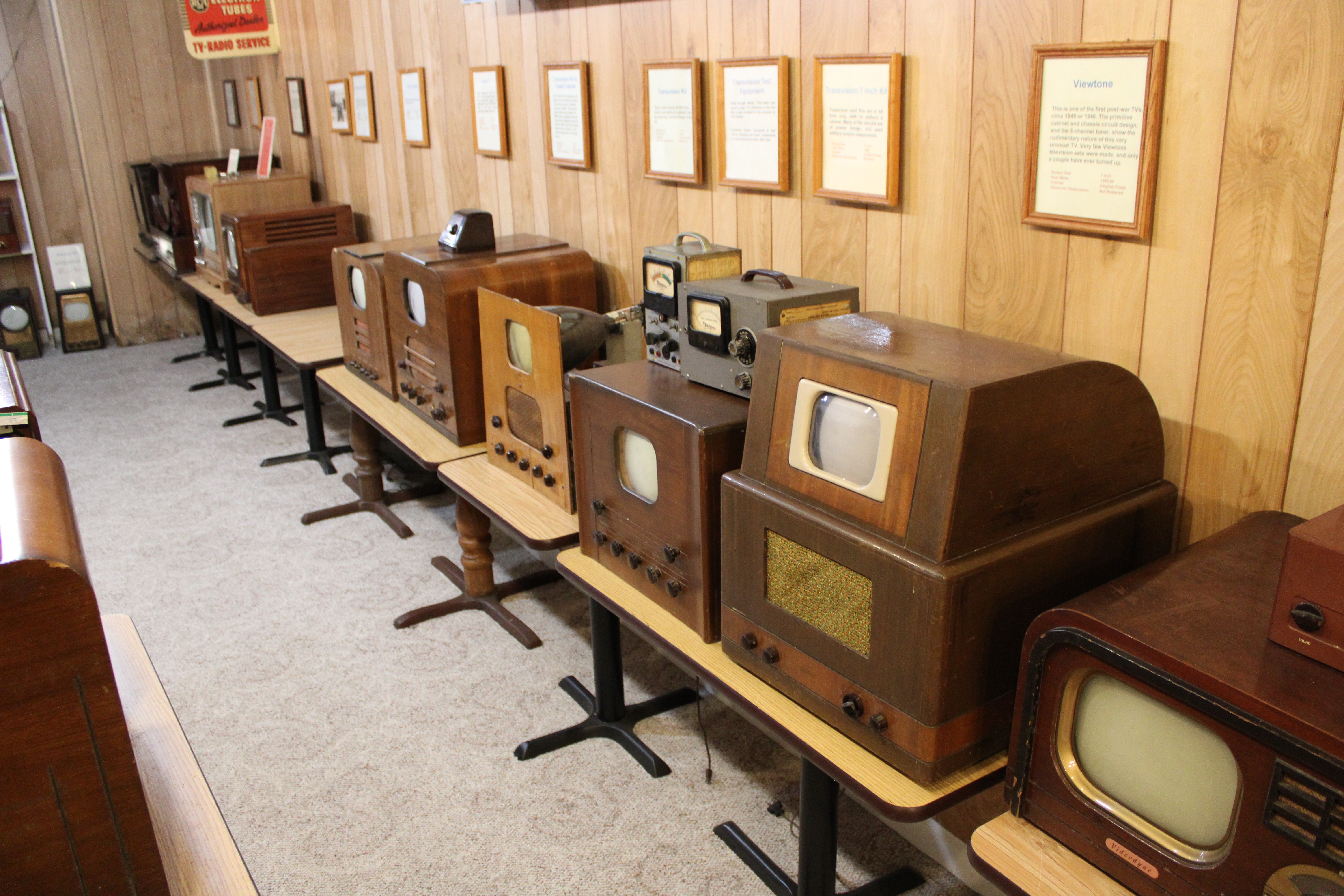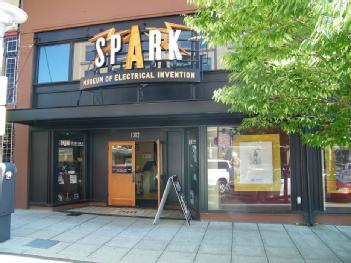|
CT-100
The RCA CT-100 was an early all-electronic consumer color television introduced in April 1954. The color picture tube measured 15 inches diagonally. The viewable picture was just 11½ inches wide. The CT-100 wasn't the world's first color TV, but it was the first to be mass produced, with 4400 having been made. The world's first color TV set was the Westinghouse H840CK15, released in March 1954, but only 500 were made and only around 30 were sold. The RCA sets were made at RCA's plant in Bloomington, Indiana. The sets cost $1000, half the price of a new low-end automobile. By the end of 1954, RCA released an improved color TV with a 21-inch picture tube. The CT-100 and its Westinghouse counterpart both suffered from color fringing around the edges of objects on the image. The CT-100, which had 36 vacuum tubes in its CTC-2 chassis (known as "Merrill" to the marketing department) was the most complicated electronic device sold to the general public at the time of its relea ... [...More Info...] [...Related Items...] OR: [Wikipedia] [Google] [Baidu] |
RCA CT-100 Screenshot
The RCA Corporation was a major American electronics company, which was founded as the Radio Corporation of America in 1919. It was initially a patent trust owned by General Electric (GE), Westinghouse, AT&T Corporation and United Fruit Company. In 1932, RCA became an independent company after the partners were required to divest their ownership as part of the settlement of a government antitrust suit. An innovative and progressive company, RCA was the dominant electronics and communications firm in the United States for over five decades. RCA was at the forefront of the mushrooming radio industry in the early 1920s, as a major manufacturer of radio receivers, and the exclusive manufacturer of the first superheterodyne sets. RCA also created the first nationwide American radio network, the National Broadcasting Company (NBC). The company was also a pioneer in the introduction and development of television, both black and white and especially color television. During this peri ... [...More Info...] [...Related Items...] OR: [Wikipedia] [Google] [Baidu] |
RCA Brands
The RCA Corporation was a major American electronics company, which was founded as the Radio Corporation of America in 1919. It was initially a patent trust owned by General Electric (GE), Westinghouse, AT&T Corporation and United Fruit Company. In 1932, RCA became an independent company after the partners were required to divest their ownership as part of the settlement of a government antitrust suit. An innovative and progressive company, RCA was the dominant electronics and communications firm in the United States for over five decades. RCA was at the forefront of the mushrooming radio industry in the early 1920s, as a major manufacturer of radio receivers, and the exclusive manufacturer of the first superheterodyne sets. RCA also created the first nationwide American radio network, the National Broadcasting Company (NBC). The company was also a pioneer in the introduction and development of television, both black and white and especially color television. During this ... [...More Info...] [...Related Items...] OR: [Wikipedia] [Google] [Baidu] |
Color Television
Color television or Colour television is a television transmission technology that includes color information for the picture, so the video image can be displayed in color on the television set. It improves on the monochrome or black-and-white television technology, which displays the image in shades of gray ( grayscale). Television broadcasting stations and networks in most parts of the world upgraded from black-and-white to color transmission between the 1960s and the 1980s. The invention of color television standards was an important part of the history and technology of television. Transmission of color images using mechanical scanners had been conceived as early as the 1880s. A demonstration of mechanically scanned color television was given by John Logie Baird in 1928, but its limitations were apparent even then. Development of electronic scanning and display made a practical system possible. Monochrome transmission standards were developed prior to World War II, but civ ... [...More Info...] [...Related Items...] OR: [Wikipedia] [Google] [Baidu] |
Cathode Ray Tube
A cathode-ray tube (CRT) is a vacuum tube containing one or more electron guns, which emit electron beams that are manipulated to display images on a phosphorescent screen. The images may represent electrical waveforms ( oscilloscope), pictures ( television set, computer monitor), radar targets, or other phenomena. A CRT on a television set is commonly called a picture tube. CRTs have also been used as memory devices, in which case the screen is not intended to be visible to an observer. The term '' cathode ray'' was used to describe electron beams when they were first discovered, before it was understood that what was emitted from the cathode was a beam of electrons. In CRT television sets and computer monitors, the entire front area of the tube is scanned repeatedly and systematically in a fixed pattern called a raster. In color devices, an image is produced by controlling the intensity of each of three electron beams, one for each additive primary color (red, gre ... [...More Info...] [...Related Items...] OR: [Wikipedia] [Google] [Baidu] |
Westinghouse H840CK15
The Westinghouse H840CK15 was the second consumer all-electronic color television set offered for sale in the United States on February 28, 1954. The set was discontinued about six months after its introduction because of larger and less expensive 19 and 21-inch color sets becoming available in July and December 1954 such as Motorola and RCA The RCA Corporation was a major American electronics company, which was founded as the Radio Corporation of America in 1919. It was initially a patent trust owned by General Electric (GE), Westinghouse, AT&T Corporation and United Fruit Comp .... The set used the 15GP22 cathode ray tube. References Products introduced in 1954 Television sets {{US-tv-stub ... [...More Info...] [...Related Items...] OR: [Wikipedia] [Google] [Baidu] |
Early Television Museum
The Early Television Museum is a museum of early television receiver sets. It is located in Hilliard, a suburb of Columbus, Ohio. The museum has over 150 TV sets including mechanical TVs from the 1920s and 1930s; pre-World War II British sets from 1936 to 1939; pre-war American sets from 1939 to 1941; post-war American, British, French and German sets from 1945 to 1960; and early color sets from 1953 to 1957 including an RCA Victor CT-100. Many of these sets are working. It is the largest collection in the United States. The Dave Johnson collection of early television cathode ray tubes is also at the museum, along with early TV studio equipment, which includes a working 60-line flying-spot scanner TV camera A professional video camera (often called a television camera even though its use has spread beyond television) is a high-end device for creating electronic moving images (as opposed to a movie camera, that earlier recorded the images on film). .... Visitors are pic ... [...More Info...] [...Related Items...] OR: [Wikipedia] [Google] [Baidu] |
SPARK Museum Of Electrical Invention
The SPARK Museum of Electrical Invention (formerly the American Museum of Radio and Electricity) is an interactive museum located in Bellingham, Washington, United States, which offers educational experiences for audiences of all ages through galleries and public programs that illustrate the development and use of electricity, radio and the related inventions that changed the course of human history. The museum features a collection of artifacts showcasing four centuries of human innovation from 1580 into the 1950s. Museum history The museum began in 1985 as an informal collection of radio sets, spare parts, schematics, recordings, and vintage magazines and manuals owned by a Bellingham resident, Jonathan WinterHistory of the Spark Museum from the museum's website Winter's collection continued to grow, and by 1998, the Bel ... [...More Info...] [...Related Items...] OR: [Wikipedia] [Google] [Baidu] |
CT-100 With CTC-2 Chassis
CT-1, CT1 and CT 1 can refer to: * ČT1, a television channel in the Czech Republic * CT1, a cordless telephone standard * Cosina CT-1, a 35mm film SLR camera * Connecticut's 1st congressional district * Connecticut Route 1 ** U.S. Route 1 in Connecticut * Cardiotrophin 1 Cardiotrophin-1 (CT-1) is a cytokine. It is a cardiac hypertrophic factor of 21.5 kDa and a protein member of the IL-6 cytokine family. Pathology CT-1 is associated with the pathophysiology of heart diseases, including hypertension, myocardia ... * Core Tier 1 Capital {{Letter-NumberCombDisambig ... [...More Info...] [...Related Items...] OR: [Wikipedia] [Google] [Baidu] |
Bloomington, Indiana
Bloomington is a city in and the county seat of Monroe County in the central region of the U.S. state of Indiana. It is the seventh-largest city in Indiana and the fourth-largest outside the Indianapolis metropolitan area. According to the Monroe County History Center, Bloomington is known as the "Gateway to Scenic Southern Indiana". The city was established in 1818 by a group of settlers from Kentucky, Tennessee, the Carolinas, and Virginia who were so impressed with "a haven of blooms" that they called it Bloomington. The population was 79,168 at the 2020 census. Bloomington is the home to Indiana University Bloomington, the flagship campus of the IU System. Established in 1820, IU Bloomington has 45,328 students, as of September 2021, and is the original and largest campus of Indiana University. Most of the campus buildings are built of Indiana limestone. Bloomington has been designated a Tree City since 1984. The city was also the location of the Academy Award� ... [...More Info...] [...Related Items...] OR: [Wikipedia] [Google] [Baidu] |
Vacuum Tube
A vacuum tube, electron tube, valve (British usage), or tube (North America), is a device that controls electric current flow in a high vacuum between electrodes to which an electric potential difference has been applied. The type known as a thermionic tube or thermionic valve utilizes thermionic emission of electrons from a hot cathode for fundamental electronic functions such as signal amplification and current rectification. Non-thermionic types such as a vacuum phototube, however, achieve electron emission through the photoelectric effect, and are used for such purposes as the detection of light intensities. In both types, the electrons are accelerated from the cathode to the anode by the electric field in the tube. The simplest vacuum tube, the diode (i.e. Fleming valve), invented in 1904 by John Ambrose Fleming, contains only a heated electron-emitting cathode and an anode. Electrons can only flow in one direction through the device—from the cathode to the ... [...More Info...] [...Related Items...] OR: [Wikipedia] [Google] [Baidu] |
Early Adopters
An early adopter or lighthouse customer is an early customer of a given company, product, or technology. The term originates from Everett M. Rogers' '' Diffusion of Innovations'' (1962). History Typically, early adopters are customers who, in addition to using the vendor's product or technology, also provide considerable and candid feedback to help the vendor refine its future product releases, as well as the associated means of distribution, service, and support. Early adoption could also be referred to as a form of testing in the early stages of a project. The relationship is synergistic. The customer receives early (and sometimes unique, or at least uniquely early) access to an advantageous new product or technology. In return, the customer may also serve as a kind of guinea pig. In exchange for being an early adopter, and thus being exposed to the problems, risks, and annoyances common to early-stage product testing and deployment, the "lighthouse customer" is sometimes g ... [...More Info...] [...Related Items...] OR: [Wikipedia] [Google] [Baidu] |
_logo.jpg)




